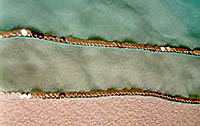
Often, the veil is made from the same material as the skirt. The same materials have proven suitable for veils, mainly polyester georgette and royal or pearl chiffon, glitter and shiny chiffon and organdy.
Silk is not suitable, it flaps in the air.
Being too lazy for ironing, I prefer crinkle-resistant material.
A hint: never fold your veils, simply drop them and gather them loosely. A folded veil will get crinkles at the same places, and I don't like dancing with a veil with tartan pattern like a tablecloth.
The semicircular veil
There are rectangular veils, however, in recent years the rounded shape has become more popular. The length depends on your height, arm length and veil experience. The standard width is approx. 1,12 m (44 inches), and a length of 2,50 m (98.5 inches) is fine in most cases.
Or you measure as follows: hold the veil in both hands with the veil horizontally around your shoulders, then bring your arms together in front of you. The parts of the veil hanging down should reach to your elbows.
Veils made of less than 90 cm (35.5 inches) wide material have somewhat different qualities, but are evenly suitable.
For cutting, I made a template of packing paper. Draw the shape of the veil on the paper with a thick black felt pen (don't cut it!). Then place the thin cloth on top and pull the edge straight, first on one side, then on the other and repeat until the material is lying straight on the template. (With a second person, it is much easier to spread the cloth!) Then start cutting.
If I do it the other way around (with the template on the cloth) I never get a straight edge.
I used this paper template for the semicircles of circular skirts. Be careful not to pick the wrong hip circle; that is fatal!
I seam all edges of my veils so that I have something to "grasp". And the edges are almost always decorated with sequin lace so that I can find the edge more easily during the dance
I have never got stuck with the sequins in my costume or my hair, maybe this can happen with voluminous wigs.
You can also edge the veil with silver or gold textile "gift parcel ribbon", that looks nice as well.
There are veils which have so little weight that they almost don't fly (as glitter chiffon by Tabou). It helps to give the edge additional weight by sewing on beads.
The easiest way in my opinion is to first apply sequin laces. Then I can stich through the centre of the sequins and get a regular edge.
But you don't really need the sequin lace, simply take the desired number of beads on the neadle and stich through say every third sequin from below.
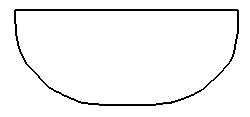 |
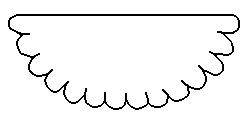 |
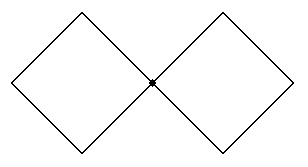
If you sew two smaller square veils together at one tip, you can make wonderful things. Simply cut two squares (approx. 112 cm wide), seam them and connect them at one tip, perhaps with a small square piece of cloth decorated with sequins.
A Cape
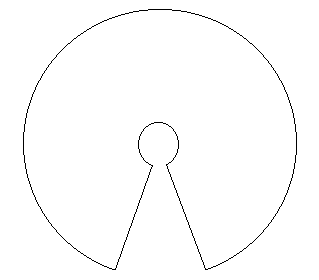
A cape can look very elegant, as you first cover up (for a dance with a candelabra, for example) and show your full costume only at a later point of time. The material has to be so long that it reaches from your neck to the floor (minimum 1.40 m width). It is 3/4 or a full circle, open to the front, with a narrow collar and closed at the throat (snap fastener, velcro). Very noble is a shiny metallic chiffon in silver, gold or any color matching the costume. This cape can consist of 2 semicircles; see the following instructions for the jagged cape.
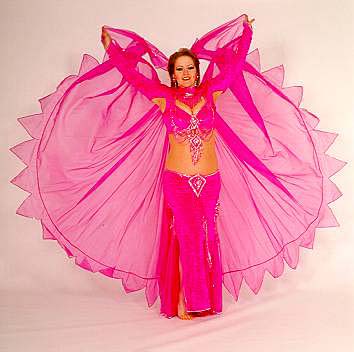
We have designed a jagged cape, here are the instructions:
It consists of 2 semicircles, approx. 130 m long, and a jagged edge, approx. 20 cm long. This jagged edge as well as all other edges and seams are decorated with sequin lace, and the wide collar has a snap fastener. I use only holo sequin lace, as it is glittering like rhinestones and is available in many different colors.
The length of the cape depends on the height of the dancer, the jagged tips may touch the floor (2 cm), too short looks awkward. The size of approx. 1.50 m applies to a woman of 1.72 m height.
We need material of at least 1.40 m width, the glitter chiffon available at Giffels or Tabou has proven very suitable, as you don't have to trim it, the tips don't get distorted and are more stable in shape due to the sequin lace.
Quantity required: approx. 7 m, sequin lace about 30 - 35 m (!!), stiff material for the collar (44 x 9 cm, folded over along the length), some elastic velvet (about 50 x 10 cm) for the collar, 1 big snap fastener, perhaps some beads for the open front edges (so that you can find it more easily during the dance) and a patient sewing machine.
Let's start:
I spread the cloth on the floor of my living room and measure a circle of about 130 cm plus a collar cut-out of about 15 cm. If the material is shorter, the jagged edge has to be longer. If the cloth is longer, the collar cutout must be larger.
How to measure this? Very easy: I fix a tape measure with a pin to the carpet, in the centre of the circle, and place pins in regular distances in the cloth. Then I cut the semicircle along these pins. To cut the second semicircle, I spread the first one upside down on the cloth.

Now the "teeth". First cut 7 strips of about 20 - 23 cm length. Simply measure the first one, cut it and use it as template for the others. For the teeth, I have made a template from a newspaper, my "teeth" are 14 cm deep and 18 cm wide.

Cutting these teeth is somewhat tricky, 3 of these strips have to be sewn together (watch the position of the cloth, my orientation is the fold in the middle of the material.)
These 2 x 3 strips (no.7 comes later!) are sewn on the semicircles. If you are very lucky, everything fits exactly, but probably it won't. You'll have a short part of the semicircle left without teeth. Now you have to apply a trick: a piece of the seventh strip, and some adjustment of the teeth: maybe cut the last tooth off the strip and make 3 shorter new ones, or 2 longer and cut a few centimetres off the semicircle (fading to the top) to obtain a straight edge (I hope anyone will understand! *smile*).
Now you finish the straight edges with a very narrow zigzag stitch from the bottom left tip of the tooth to the collar cutout and on to the bottom right tooth tip (see "sewing of hems"). Then sew the two semicircles together in the back for a length of 10 cm.
Now, you need a strip of stiff material, about 9 cm wide and 44 cm long (get your neck circumference). Fold it over (to 4.5 cm width) and finish the edges with zigzag hem. Pin the cape to the top of this collar. I mark the middle of the collar and fix the middle of the cape and the two outer ends with pins. Then you need pins and a good eye for the folds. The material should be distributed evenly. When you got it, sew the cape on the collar with narrow zigzag stitches.
First try it on: close the collar with a safety pin and look into the mirror! Too long? Good! You can cut it shorter any time!
Too short? Only a bit? Simply fix the cape a little bit lower on the collar.
Muuuch too short?? What a pity, then you need a longer collar. If you are lucky, nobody will see it.
Now comes the sequin lace. It has to be placed in the correct direction: place it in front of you as if inserting it in the sewing machine and hold the end away from you. Strike along the lace with your finger towards yourself: it is placed correctly if it is smooth in this direction, if it is rough, the sewing machine will probably make some trouble. In that case, place the lace the other way around.
The idea of having to sew 33 m of sequin laces does not sound too inviting, but it is worthwhile! I have made the experience that the different colors behave differently under the machine. Red or violet lace is difficult to handle, the sequins burst under the needle. Silver is currently quite tough, golden one, however, works smoothly. I use a thin needle, which comes up again easily without pulling the sequins up and twisting them.
I try to have one hand in front of the needle and the other one behind it to keep the lace under control and straight on the cloth.
Sometimes a lace tends to move to the left (yes, like a defect brake!) and it is very difficult to stay on track. Especially tricky is to sew around the corner at the tips before you get hold of the cloth again behind the needle and put some pressure on it.
(To relax from the teeth) I sew sequin lace on the straight seam on which the jagged edge was fixed.
Now try first: how can you whirl with this cape? You will realize the weight of the sequins, when spinning quickly, the cape gets a good speed!
Now you cover the collar with elastic velvet. I do this by hand, as the velvet tends to get distorted under the machine. I try to get the backside nice. The cape is closed with a thick snap fastener, strong enough to remain closed; it can be opened discreetly during the dance when you want to get rid of the cape.
Then I decorate the edges of the collar with sequin lace. This place is often touched with fingers moist from sweat so that the sequins loose their color and become transparent, pale and invisible. Therefore, I started applying loose sequins with a bead on top of each in this area, so that replacing is a bit easier.
Another highlight is the decoration of the straight front edge with beads so that I will easily find it during the dance. The weight of the beads gives the edge more speed.
Enjoy yourself!
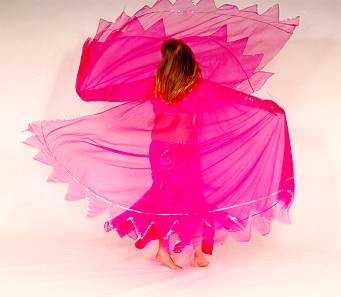
Copyright © 2000-2012 by Nadya - All rights reserved.
Last modified: